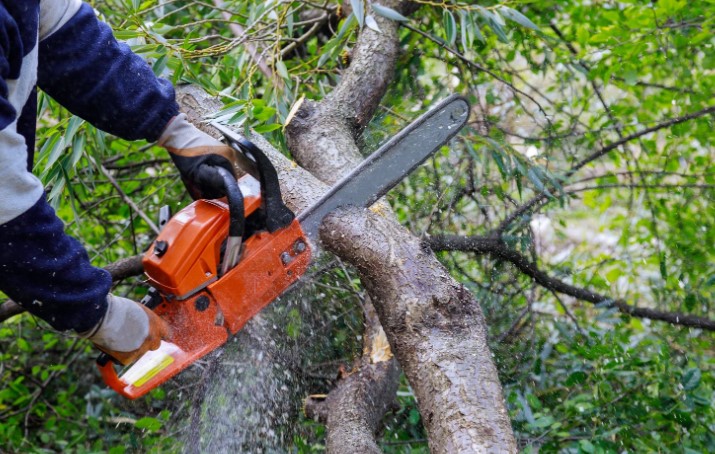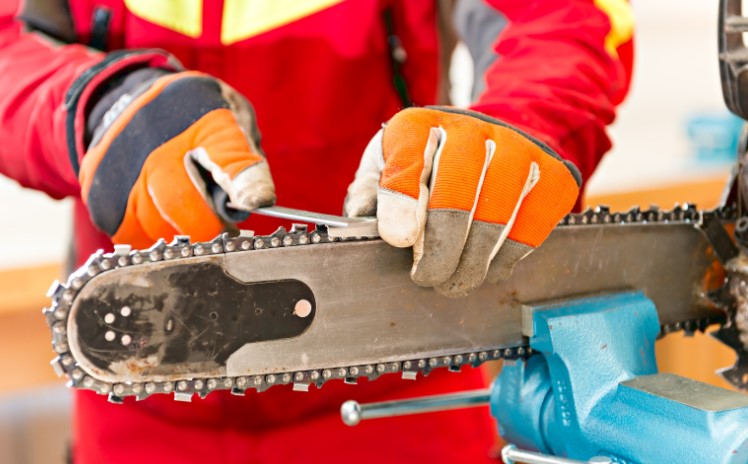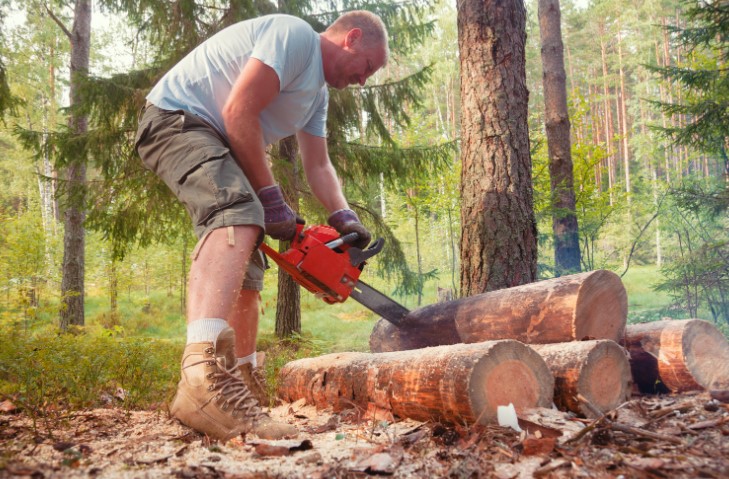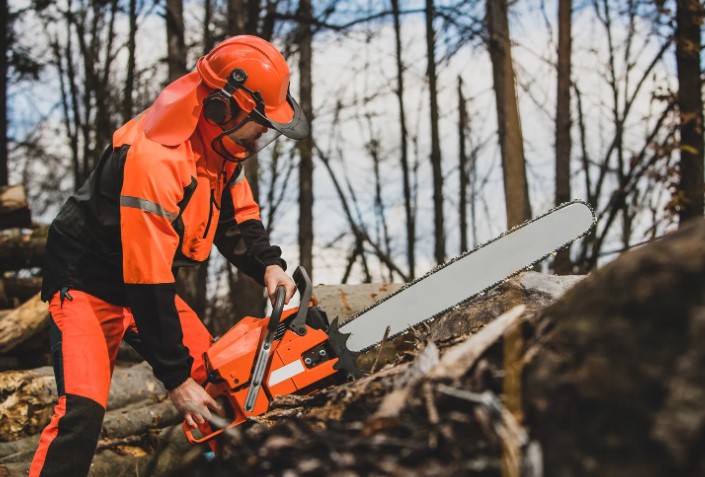- How Do I Know My Chainsaw Needs Sharpening?
- What Tools Do I Need to Sharpen My Chainsaw?
- How to Prepare Before Sharpening?
- Step-by-Step: How To Sharpen a Chainsaw with a File?
- What Are the Most Common Filing Mistakes?
- How Often Should I Sharpen My Chainsaw?
- When Should I Replace the Chain Instead of Sharpening?
- Is Filing Better Than an Electric Sharpener?
- Smart Chainsaw Care: My Final Tips
- Conclusion
Keeping a chainsaw sharp is one of the smartest things I’ve learned when it comes to tool maintenance. A dull chain doesn’t just slow you down — it can also be dangerous.
In this guide, I’ll walk you through everything I know about how to sharpen a chainsaw with a file, with a focus on clarity, safety, and simplicity.
Whether you’re an occasional user or use your saw regularly, sharpening the right way will help you get clean cuts and reduce wear on your machine.
How Do I Know My Chainsaw Needs Sharpening?
What Are the Signs of a Dull Chainsaw?
There are always a few telltale signs that tell me it’s time to sharpen the chain. If I notice any of the following, I know it’s time to stop and reach for my file:
- The saw pulls in one direction while cutting.
- I need to apply more pressure than usual.
- It creates fine sawdust instead of coarse wood chips.
- The chain can produce smoke, even if it’s properly lubricated.
- The cut surface looks uneven or rough.
How Does a Sharp vs. Dull Chain Perform?
A sharp chain cuts quickly and smoothly, producing large, thick wood chips. On the other side, a dull chain will struggle, bog down the motor & leave me with poor-quality cuts.
The saw feels like it’s working harder than it should — and so am I. In my experience, a freshly sharpened chain makes the work easier, safer, and much more efficient.

What Tools Do I Need to Sharpen My Chainsaw?
What Is a Chainsaw File and How Does It Work?
A chainsaw file is a round file designed to match the curvature of the chain’s cutting teeth. This file helps restore the cutting edge by removing just enough metal to sharpen the tooth without damaging it.
It’s a manual, low-cost method — and it’s what I personally prefer for control and precision.
Understanding File Sizes and Types
Not all chains use the same file size. Using the correct diameter file is crucial, as the wrong size can round the tooth incorrectly or remove too much metal.
I always check the chain pitch and match it to the proper file diameter.
Here’s a simple guide I follow:
| Chain Type | Pitch | File Diameter |
| 3/8″ Low Profile | 0.375″ | 4.0 mm |
| .325″ | 0.325″ | 4.8 mm |
| 3/8″ | 0.375″ | 5.2 mm |
| .404″ | 0.404″ | 5.5 mm |
If you’re unsure, the chain packaging or manufacturer website often lists the file size required.
Do I Need a File Guide or Filing Kit?
While it’s possible to sharpen without a guide, I’ve found a file guide to be incredibly helpful — especially when I was learning. A filing kit typically includes:
- A round file
- A file guide (to help maintain correct angles)
- A flat file (for adjusting the depth gauges)
- A depth gauge tool
- A file handle
These tools work together to keep each tooth uniform and ensure consistent cutting performance.

How to Prepare Before Sharpening?
Safety First – What Gear Should I Use?
Sharpening may not seem dangerous, but I treat it with just as much caution as cutting. Before I start, I make sure I’m wearing:
- Heavy-duty gloves to protect my hands
- Safety goggles to protect my eyes from metal filings as a shield
- Sturdy boots with good grip
- Long sleeves or a protective apron
A solid workspace, preferably a bench or log stand, helps ensure I’m working safely and comfortably.
How Do I Secure the Chainsaw for Filing?
Securing the chainsaw properly is key to a clean, even filing job. I usually clamp the chainsaw bar in a bench vice to keep it stable.
If I’m in the field, I use a bar clamp that attaches to a stump or log. The key is to make sure the chain is locked in place but still moves freely when rotated manually.
Should I Clean the Chain First?
Absolutely. Dirt, resin, and debris can make filing difficult and cause uneven sharpening.
I always brush off the chain using a stiff-bristled brush and sometimes use a degreaser if the buildup is heavy. A clean chain helps the file grip better and provides a smoother sharpening motion.
Step-by-Step: How To Sharpen a Chainsaw with a File?
Step 1: Find the Master Cutter
I start by locating the shortest cutter on the chain.
This tooth is my reference, or master cutter, and I file all the others to match its length. I mark it with a permanent marker so I know where I began.
Step 2: Align the File at the Right Sharpening Angle
Most chainsaw teeth are sharpened at an angle between 25° & 35°, based on the type of the chain.
Some filing guides have markings to help with this, or I use a sharpening template for accuracy. I always check the manufacturer’s recommendations to make sure I’m using the correct angle.
Step 3: File Each Tooth Correctly
Holding the file at the correct angle, I push it away from me in smooth, even strokes — never back and forth.
I typically apply 4–6 strokes per tooth, depending on how dull it is. It’s important to apply consistent pressure and keep the strokes level.
I sharpen every other cutter on one side of the chain, then rotate the saw to file the cutters on the opposite side.
Step 4: Check the Depth Gauges
The depth gauge, also called a raker, controls how deep each tooth cuts into the wood. If the depth gauge is too high, the tooth won’t bite properly.
Too low, and it cuts too aggressively, leading to vibration and kickback.
Using a depth gauge tool, I check each raker and file it down with a flat file if it sits above the tool’s profile.
Step 5: Tension the Chain After Sharpening
Once all teeth and rakers are sharpened, I check the chain tension.
It should snap back into place when pulled slightly away from the bar, but still move freely when rotated by hand. If it’s too tight or too loose, I adjust it accordingly.

What Are the Most Common Filing Mistakes?
Are You Filing Too Much or Too Little?
Removing too much material can shorten the life of your chain, while filing too little leaves it dull and ineffective.
I aim to remove just enough metal to restore the edge without making the cutter uneven or worn.
Is Your File at the Wrong Angle?
Angle inconsistency can ruin the cutting edge and reduce efficiency.
Early on, I made this mistake often until I started using a guide consistently.
Did You Forget the Depth Gauge?
Neglecting the depth gauge is one of the most overlooked steps.
Even if the teeth are razor-sharp, a high raker will make the saw cut poorly. I include this step every time I sharpen — it’s worth it.
How Often Should I Sharpen My Chainsaw?
What Affects Sharpening Frequency?
I sharpen my chain after every 1–2 hours of cutting time, but some situations wear the teeth out faster. For example:
- Cutting dirty or muddy wood
- Striking a rock or metal object
- Working with frozen or treated wood
Frequent inspections help me decide when to sharpen rather than waiting for a noticeable drop in performance.
Can Over-Sharpening Wear Down the Chain?
Yes. Every time I sharpen, a small layer of metal is removed. Eventually, the teeth become too short to be effective or safe.
I keep an eye on their length — if they’re significantly shorter than when new, it’s time for a replacement.

When Should I Replace the Chain Instead of Sharpening?
Is It Still Safe to Use?
There are times when no amount of sharpening will restore a chain. I replace mine if:
- Teeth are cracked, chipped, or broken
- There are multiple missing teeth
- The chain no longer holds tension properly
- It feels unbalanced even after proper sharpening
Chains are wear parts — replacing them at the right time is part of smart maintenance.
How Many Times Can a Chain Be Sharpened?
On average, I get about 3 to 5 full sharpenings from a chain before it becomes too worn down.
That number can vary depending on how aggressive the filing is and the materials I’m cutting.
Is Filing Better Than an Electric Sharpener?
Pros and Cons of Manual Filing
In my experience, manual filing has clear advantages and some limitations:
Advantages:
- Greater control and precision
- Quiet and portable (no power needed)
- More affordable long-term
Disadvantages:
- Time-consuming if the chain is very dull
- Requires practice to master the angles
- Less ideal for heavily damaged chains
Why I Prefer Using a File for My Chainsaw?
I’ve used electric sharpeners before, but I always come back to the hand file. It’s portable, easy to carry in the field, and gives me full control over each cutter.
Plus, I can touch up the chain after just a few minutes of use, which keeps it cutting smoothly all day.

Smart Chainsaw Care: My Final Tips
Maintaining my chainsaw isn’t just about sharpening. It’s about building a routine that ensures consistent performance. Here are the items I always keep in my maintenance kit:
Chainsaw Maintenance Essentials:
- Correct round file and file guide
- Flat file and depth gauge tool
- Permanent marker (to mark the master cutter)
- Bar clamp or vice for securing the saw
- Brush for cleaning the chain
- Chain oil and bar cleaner
- Spare chain (for quick swaps)
By following this sharpening process regularly, I’ve extended the lifespan of my chains, improved my cutting results, and made chainsaw work a lot more enjoyable.
Conclusion
Learning how to sharpen a chainsaw with a file has saved me time, money, and frustration. It’s a skill that might take a bit of practice, but once you get the hang of it, it becomes second nature.
With the right tools, technique, and care, your chainsaw will always be ready to tackle the next job — smoothly and safely.
If you’re just getting started, stick with the basics, use a guide if needed, and trust the process. A well-sharpened chain truly transforms the way your saw performs.
Related Article: Inexpensive Raised Garden Bed Ideas


0 Comments